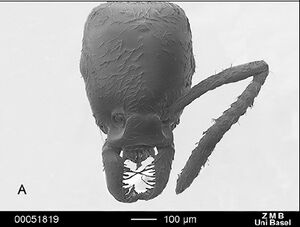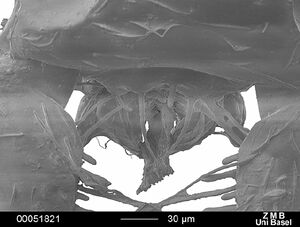Protanilla schoedli
| Protanilla schoedli | |
|---|---|

| |
| Scientific classification | |
| Kingdom: | Animalia |
| Phylum: | Arthropoda |
| Class: | Insecta |
| Order: | Hymenoptera |
| Family: | Formicidae |
| Subfamily: | Leptanillinae |
| Tribe: | Leptanillini |
| Genus: | Protanilla |
| Species: | P. schoedli |
| Binomial name | |
| Protanilla schoedli Baroni Urbani & De Andrade, 2006 | |
The discovery of Protanilla schoedli allows hypothecation of the presence of "normal" gynes with wings and eyes in the two leptanilline genus Protanilla as opposed to dichthadii-form gynes in Leptanilla. The winged state of Protanilla, however, is the plesiomorphic condition. Biogeographically, the record of P. schoedli from Sri Lanka represents a considerable but not surprising extension of the previously known distribution of the genus in the Oriental region. (Baroni Urbani & De Andrade, 2006)
Photo Gallery
Identification
Baroni Urbani & De Andrade (2006) - Protanilla species differing from the other species of the genus as follows: from Protanilla furcomandibula by the mandibles lacking latero-ventral teeth and by the ventral margin of postpetiole being convex instead of concave; from Protanilla bicolor by the funicular joints being about as broad as long in stead of broader than long and by the body being concolorous instead of bicoloured; from Protanilla concolor, by the anterolateral sides of the head close to the antennal insertion being weakly pointed instead of concave and by the anterior face of the first gastral tergite being gently con-cave instead of straight.
No convincing differences were detected from Protanilla rafflesi, described from Singapore, based on the few published measurements available for the latter. Since the gyne-based P. schoedli and the worker-based P. rafflesi are known on different castes, differences in size could be caste-dependent. We are confident that the geographic heterogeneity of the two specimens will imply morphological heterogeneity as well.
Keys including this Species
Distribution
Distribution based on Regional Taxon Lists
Oriental Region: Sri Lanka (type locality).
Distribution based on AntMaps
Distribution based on AntWeb specimens
Check data from AntWeb
Countries Occupied
| Number of countries occupied by this species based on AntWiki Regional Taxon Lists. In general, fewer countries occupied indicates a narrower range, while more countries indicates a more widespread species. |

|
Estimated Abundance
| Relative abundance based on number of AntMaps records per species (this species within the purple bar). Fewer records (to the left) indicates a less abundant/encountered species while more records (to the right) indicates more abundant/encountered species. |

|
Biology
Castes
Queen
  
| |
| . | |
Nomenclature
The following information is derived from Barry Bolton's Online Catalogue of the Ants of the World.
- schoedli. Protanilla schoedli Baroni Urbani & De Andrade, 2006: 45, figs. 1 3 (q.) SRI LANKA.
Unless otherwise noted the text for the remainder of this section is reported from the publication that includes the original description.
Description
Queen
Total Length, combined head length in full-face view (closed mandibles included), Weber's length of mesosoma, petiole and postpetiole lengths (in profile) and length of gaster (in profile): 3.75; Head Length, maximum measurable distance between medial margin of vertexal angles and anteromedial margin of clypeus with head in full frontal view: 0.59; Head Width, maximum measurable head width with head in full frontal view: 0.45; Scape Length, length of scape shaft, excluding basal condyle: 0.46; Mandible Length, maximum length of mandible between anteromedial margin of clypeus and mandibular apex: 0.26; Eye Length, maximum diameter of eye: 0.12; Petiole Length, maximum measurable length on petiole transversal plane: 0.29; Petiole Width, maximum measurable width of petiole in dorsal view: 0.27; Petiole Height, maximum measurable height on petiole sagittal plane: 0.35; Postpetiole Length, maximum measurable length on postpetiole transversal plane: 0.27; Postpetiole Width, maximum measurable width of postpetiole in dorsal view: 0.29; Postpetiole Height, maximum measurable height on postpetiole sagittal plane: 0.37; Weber's Length, diagonal length of mesosoma from anterior pronotal border (excluding neck) to distal edge of propodeal lobe 1.02; Cephalic Index, (Head Width / Head Length) × 100: 76.3; Scape Index (Scape Length / Head Length) × 100: 102.2.
Head gently convex, about one fourth longer than broad and with sides converging anteriorly and ending in minute denticle. Vertex with subrounded corners and almost straight margin. Compound eyes large, slightly behind midlength of head, gently convex and with reduced interommatidial pilosity. Ocelli small and weakly salient. Posterior half of clypeus superficially raised, subrectangular and with internal median longitudinal line visible in transparency. Anterior part of clypeus broad, feebly protruding and declivous anteriorly; its anterior border almost straight. Antennal fossae superficially concave. Scapes subcylindrical and reaching vertexal margin posteriorly. Funicular joints 2 - 10 about as broad as long. Joints 1 and 11 longer than broad. Mandibles triangular, slightly shorter than one half of head length, downcurved apically, each with 16 "pencil-like denticles" and 3 long + 3 apical, short, probable trigger hairs, lower on internal face. These "denticles" are modified hairs since a medial, similar "denticle" is visible on the anterior border of the labrum (Fig. 3). Outer margin of mandibles with laterobasal pit subtended by distinct longitudinal groove running anteriorly and traversing width of mandibles before narrow apex.
Mesosoma elongate. Pronotum about as long as mesonotum in dorsal view. Parapsidal furrows superficially impressed. Scutellum subrounded. Propodeum in profile convex.
Petiole slightly longer than broad, with short neck anteriorly and posteriorly. Anterior neck denticulate on sides, with denticles separated by faint margin. Petiolar node high, convex and broader than long. Ventral surface of petiole with subrounded tooth on anterior fourth, tooth directed anteriorly; remaining three fourths of ventral surface of petiole strongly convex medially. Postpetiole slightly broader than long, with short neck posteriorly only. Postpetiolar node high and convex. Ventral surface of postpetiole strongly convex.
Gaster elongate oval. Base of first tergum weakly incised medially.
Sculpture. Body smooth and shining with minute, sparse, piligerous punctures only.
Pilosity. Body with short, appressed hairs; similar hairs but shorter and suberect or subdecumbent on antennae. In addition, a few, rare, longer, suberect hairs sparse on body.
Colour. Light yellowish-brown.
Type Material
Holotype dealate gyne (unique) from Sri Lanka labelled "CEYLAN, Uva, Inginirgala, 12.II.1970, Mussard, Besuchet & Löbl", in the Natural History Museum of Geneva, Switzerland. A damaged specimen. Only the left foreleg remains and the right antenna is also missing. The hairs are partly glued and the photographs were taken without coating the specimen.
Etymology
This species is named in memory of Dr. Stefan Schödl.
References
- Aswaj, P., Anoop, K., Priyadarsanan, D.R. 2020. First record of the rarely collected ant Protanilla gengma Xu, 2012 (Hymenoptera, Formicidae, Leptanillinae) from the Indian subcontinent. Check List 16, 1621–1625 (doi:10.15560/16.6.1621).
- Baroni Urbani, C. & De Andrade, M.L. 2006. A new Protanilla Taylor, 1990 from Sri Lanka. Myrmecologische Nachrichten 8: 45-47.
- Dias, R.K.S., Yamane, S., Ali Akbar, S., Peiris, H.A.W.S., Wachkoo, A.A. 2019. Discovery of the worker caste of Protanilla schoedli Baroni Urbani & De Andrade (Formicidae: Leptanillinae) in Sri Lanka. Oriental Insects 53, 160-166 (doi:10.1080/00305316.2018.1476273).
- Griebenow, Z. 2024. Systematic revision of the ant subfamily Leptanillinae (Hymenoptera, Formicidae). ZooKeys 1189, 83–184 (doi:10.3897/zookeys.1189.107506).
References based on Global Ant Biodiversity Informatics
- Baroni Urbani C., and M. L. De Andrade. 2006. A new Protanilla Taylor, 1990 from Sri Lanka. Myrmecologische Nachrichten 8: 45-47.
- Dias R. K. S., S. Yamane, S. A. Akbar, H. A. W. S. Peiris, and A. A. Wachkoo. 2018. Discovery of the worker caste of Protanilla schoedli Baroni Urbani & De Andrade (Formicidae: Leptanillinae) in Sri Lanka. Oriental Insects https://doi.org/10.1080/00305316.2018.1476273
- Dias R. K. S., S. Yamane, S. A. Akbar, H. A. W. S. Peiris, and A. A. Wachkoo. 2019. Discovery of the worker caste of Protanilla schoedli Baroni Urbani & De Andrade (Formicidae: Leptanillinae) in Sri Lanka. Oriental Insects 53: 160-166.
- Terayama, M. 2009. A synopsis of the family Formicidae of Taiwan (Insecta; Hymenoptera). The Research Bulletin of Kanto Gakuen University 17: 81-266.


